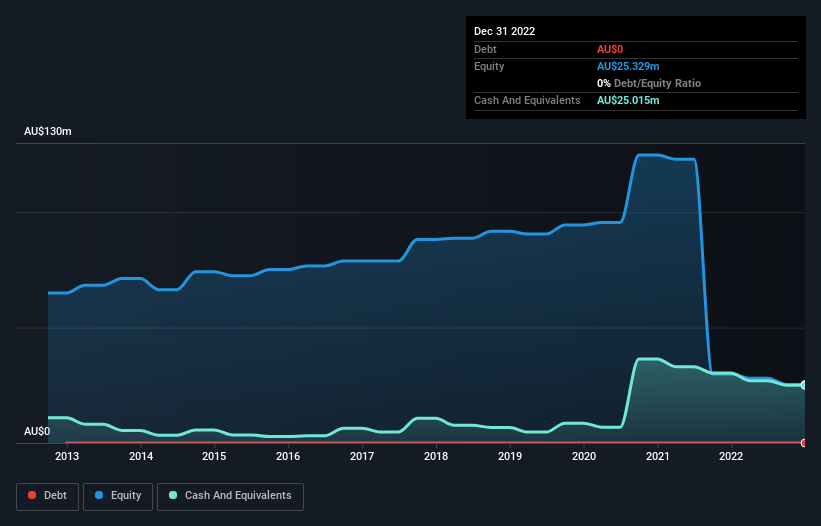Companies Like Energy Transition Minerals (ASX:ETM) Are In A Position To Invest In Growth
We can readily understand why investors are attracted to unprofitable companies. For example, although software-as-a-service business Salesforce.com lost money for years while it grew recurring revenue, if you held shares since 2005, you'd have done very well indeed. Having said that, unprofitable companies are risky because they could potentially burn through all their cash and become distressed.
So, the natural question for Energy Transition Minerals (ASX:ETM) shareholders is whether they should be concerned by its rate of cash burn. For the purposes of this article, cash burn is the annual rate at which an unprofitable company spends cash to fund its growth; its negative free cash flow. The first step is to compare its cash burn with its cash reserves, to give us its 'cash runway'.
View our latest analysis for Energy Transition Minerals
How Long Is Energy Transition Minerals' Cash Runway?
A company's cash runway is calculated by dividing its cash hoard by its cash burn. As at December 2022, Energy Transition Minerals had cash of AU$25m and no debt. Importantly, its cash burn was AU$5.3m over the trailing twelve months. That means it had a cash runway of about 4.7 years as of December 2022. A runway of this length affords the company the time and space it needs to develop the business. You can see how its cash balance has changed over time in the image below.
How Is Energy Transition Minerals' Cash Burn Changing Over Time?
While Energy Transition Minerals did record statutory revenue of AU$372k over the last year, it didn't have any revenue from operations. That means we consider it a pre-revenue business, and we will focus our growth analysis on cash burn, for now. While it hardly paints a picture of imminent growth, the fact that it has reduced its cash burn by 21% over the last year suggests some degree of prudence. Energy Transition Minerals makes us a little nervous due to its lack of substantial operating revenue. So we'd generally prefer stocks from this list of stocks that have analysts forecasting growth.
How Hard Would It Be For Energy Transition Minerals To Raise More Cash For Growth?
While Energy Transition Minerals is showing a solid reduction in its cash burn, it's still worth considering how easily it could raise more cash, even just to fuel faster growth. Issuing new shares, or taking on debt, are the most common ways for a listed company to raise more money for its business. Many companies end up issuing new shares to fund future growth. By comparing a company's annual cash burn to its total market capitalisation, we can estimate roughly how many shares it would have to issue in order to run the company for another year (at the same burn rate).
Since it has a market capitalisation of AU$56m, Energy Transition Minerals' AU$5.3m in cash burn equates to about 9.5% of its market value. Given that is a rather small percentage, it would probably be really easy for the company to fund another year's growth by issuing some new shares to investors, or even by taking out a loan.
How Risky Is Energy Transition Minerals' Cash Burn Situation?
It may already be apparent to you that we're relatively comfortable with the way Energy Transition Minerals is burning through its cash. In particular, we think its cash runway stands out as evidence that the company is well on top of its spending. Its weak point is its cash burn reduction, but even that wasn't too bad! Looking at all the measures in this article, together, we're not worried about its rate of cash burn; the company seems well on top of its medium-term spending needs. On another note, Energy Transition Minerals has 3 warning signs (and 2 which are significant) we think you should know about.
Of course, you might find a fantastic investment by looking elsewhere. So take a peek at this free list of interesting companies, and this list of stocks growth stocks (according to analyst forecasts)
Have feedback on this article? Concerned about the content? Get in touch with us directly. Alternatively, email editorial-team (at) simplywallst.com.
This article by Simply Wall St is general in nature. We provide commentary based on historical data and analyst forecasts only using an unbiased methodology and our articles are not intended to be financial advice. It does not constitute a recommendation to buy or sell any stock, and does not take account of your objectives, or your financial situation. We aim to bring you long-term focused analysis driven by fundamental data. Note that our analysis may not factor in the latest price-sensitive company announcements or qualitative material. Simply Wall St has no position in any stocks mentioned.

